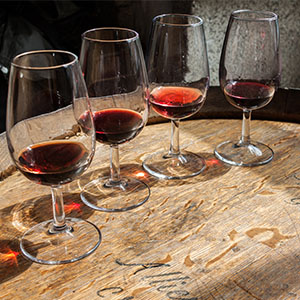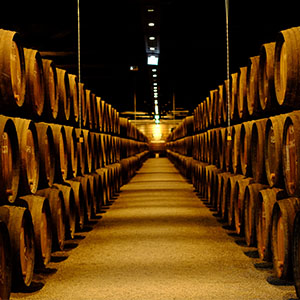Celebrated wine aficionado, Ron Kapon, who is known in wine circles as the Peripatetic Oenophile — the traveling wine expert — answers questions that Cheese Connoisseur readers have asked.
Cheese Connoisseur: How did Port first originate?

Ron Kapon: In the early 1700’s, when England and France were at war, the king of England banned French wines. Seeing an opportunity, Spanish and Portuguese merchants began shipping wines in barrels to England. But many of these wines went bad during the voyage, either because of temperature levels or fluctuations or because they were not able to withstand the often-violent movements below deck. In an effort to preserve their wines, the shippers began adding brandy, thus creating fortified wine. The English grew accustomed to this higher-alcohol beverage, and a new type of wine was created.
C.C.: How do you make a fortified wine?
R.K.: To make a fortified wine, grape spirit is added at different stages of the fermentation process, depending on the style desired. The addition of this alcohol has the effect of killing off the yeast and stopping fermentation, leaving residual sugar behind, while at the same time producing an alcohol level of 17 to 20 percent. Still, these wines generally attain an alcohol level of between 10 and 14 percent after fermentation, though some are higher. If brandy is added before or slightly after the fermentation process begins, the result is a sweet, rich, fortified wine, such as Port. Adding brandy afterwards results in a sherry or dry vermouth.
C.C.: Tell me about the origin of Port.

R.K.: Port is a fortified wine produced in the Demarcated Region of the Douro, Portugal. Officially, real Port wine comes only from Portugal, very much the same way that true Champagne comes from the Champagne region of France. Port wine takes its name from the Portuguese city of Oporto, where the major Port houses have their headquarters. Grapes actually are grown on the rocky and terraced hillsides overlooking the Douro River in the Northern provinces. Though Port had been crafted in the Douro Valley for centuries, it was the British merchants of the 17th and 18th centuries who helped make Port famous. The British loved their Claret (Bordeaux), but had problems with the French government. The wines of Portugal, they found,were a perfect substitute.
C.C.: What are the grape varieties used in making Port?
R.K.: Port can be made from over 40 grape varieties. The most important are Touriga Nacional, Touriga Franca, Tinta Roriz, Tinta Barroca, Tinto Cão and Tinta Amarela.
After a brief fermentation to about 6 percent alcohol, the still fermenting grape juice is poured off into larger containers holding alcohol, which kills the yeast and stops fermentation, resulting in alcohol levels of 18-20 percent. The young wine is then put in barrels and shipped from the vineyards down the Douro to the Port warehouses in Villa Nova de Gaia, where it stays for a year or two. While aging in wood, Port wine’s fruity aroma develops through oxidation to create a bouquet that is reminiscent of dried fruit, toasting, wood and spices. The aging process also adds to its smoothness, while making the bouquet more complex.

C.C.: What are the major styles of Port?
R.K.: There are two types of Ports — those primarily aged in bottles and those primarily aged in wood casks. Wood-aged Ports are ready to drink upon release, whereas the bottle-aged Ports require several years of aging prior to release. Bottle Ports mature after two years of cask aging. They will age for decades in that bottle, softening and maturing, and will develop sediment, as they receive no filtration prior to bottling.
Ruby Port is the label given to wines that display a deep color; they are fairly fruity and are usually aged for between three and five years. They are stored in concrete stainless steel containers or wood barrels for two to three years. It is the least expensive and most readily available Port. It tends to be young and fruity in style.
Like Ruby, Tawny Port gets its name from its color — a mahogany brown. These Ports are aged in smaller wood casks and, consequently, get more oxidization that produces their tawny color. Again, they are blended from multiple harvests. After aging from two to seven years, they are ready to drink when bottled. Aged Tawny Port is a blend of Tawny Ports aged for 10, 20, 30 or 40 years. The age is shown on the label and indicates an average age of the wine.

Late Bottled Vintage (LBV) Port is also from a single year, only it’s borne from years of excellent quality and is aged longer in wood barrels than is the case with vintage Port. Generally, it is bottled between the fourth and sixth year after it is made. It is red in color, full-bodied and smooth. Traditionally, these are ready to drink upon release.
Vintage Port, as the name suggests, are wines of superior quality, produced in exceptionally great years. They are kept in wooden barrels for two to three years of oxidative aging before being bottled. But with age, the Port’s bouquet becomes balanced. If you want to gauge whether you would like a vintage Port, ask yourself how a bouquet of chocolate, cocoa, coffee and cigars combined with spices, such as cinnamon and pepper, sounds.
Bottle aging is slow, and maturity can take a decade or more. Vintage Ports have not been fined or filtered, so decanting is often needed.
White Port is actually pale, straw and golden white, and gets its shade through the methods by which it is made. White port that has been aged for many years in wood obtains the same golden color that very old tawnies have. This type is consumed mainly as an aperitif.



